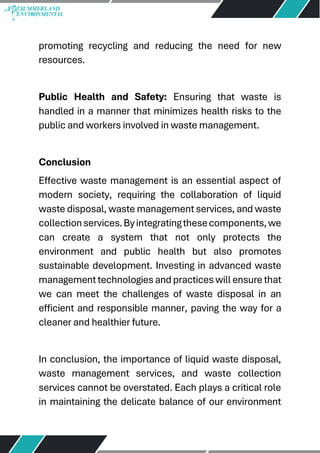Some Of Reclaim Waste
Some Of Reclaim Waste
Blog Article
All About Reclaim Waste
Table of ContentsGetting The Reclaim Waste To WorkThe Single Strategy To Use For Reclaim WasteThe Ultimate Guide To Reclaim WasteThe smart Trick of Reclaim Waste That Nobody is Talking AboutThe Facts About Reclaim Waste Uncovered
Domestic sewage waste refers to the waste and products from a household septic storage tank. The appropriate monitoring and disposal of residential sewage waste need liquid waste to be moved to a sewer treatment plant where the appropriate techniques and tools are applied to cleanse and dispose of waste.
Commercial waste frequently includes possible hazards, such as combustible materials or a combination of liquid and strong waste products, and needs a more innovative and detailed disposal process. The disposal of industrial waste commonly involves the purification of waste before transport to make certain safe and proper disposal. Industrial waste is produced from results and runoff of industrial processes and production.
This sort of waste can not utilize the very same sewage management transportation or processes as septic or business liquids. The hazardous waste management procedure calls for the evaluation and testing of liquid waste prior to it goes through the disposal procedure (liquid waste removal). Runoff waste is the fluid waste that originates from runoff and excess stormwater in very inhabited locations or cities
Runoff waste can create contamination and flooding if not managed effectively. Discover more regarding sewer cleansing and waste management. Making sure proper waste management can prevent calamities and minimize ecological damage. Both people in domestic setups and specialists in commercial or production markets can benefit from recognizing the procedures and laws of liquid waste administration.
See This Report about Reclaim Waste
Call PROS Solutions today to learn more about our waste monitoring and disposal services and the appropriate means to care for the liquid waste you generate.
(https://www.slideshare.net/leonaube33101)This supposed 'wastewater' is not just an essential source but, after therapy, will be released to our land, waterways or the sea. Utilized water from commodes, showers, baths, cooking area sinks, washings and industrial processes is understood as wastewater.

water utilized to cool down machinery or clean plant and devices). Stormwater, a kind of wastewater, is drainage that flows from agricultural and metropolitan locations such as roof coverings, parks, yards, roadways, courses and rain gutters into stormwater drains pipes, after rain. Stormwater streams without treatment directly to neighborhood creeks or rivers, eventually getting to the sea.
Our Reclaim Waste Statements
In Queensland, many wastewater is dealt with at sewer treatment plants. Wastewater is delivered from residential or commercial sites with a system of sewers and pump stations, known as sewage reticulation, to a sewer treatment plant.
The Department of Natural Resources advises city governments about handling, operating and keeping sewerage systems and therapy plants. In unsewered locations, local governments might require owners to mount private or household sewage therapy systems to straight from the source treat domestic wastewater from commodes, cooking areas, restrooms and washings. The Department of Natural Resources authorises making use of house systems when they are verified to be reliable.
The majority of stormwater receives no therapy. In some new neighborhoods, treatment of some stormwater to eliminate litter, sand and crushed rock has started making use of gross contaminant catches. Wastewater therapy takes place in four stages: Removes strong issue. Larger solids, such as plastics and other items wrongly released to drains, are removed when wastewater is travelled through screens.
Wastewater then flows right into big storage tanks where solids clear up and are gotten rid of as sludge. Oil and residue are skimmed from the surface area. Utilizes tiny living microorganisms called micro-organisms to break down and eliminate remaining dissolved wastes and great fragments. Micro-organisms and wastes are included in the sludge. Eliminates nitrogen and phosphorus nutrients that could trigger algal blooms in our rivers and threaten aquatic life.
Fascination About Reclaim Waste
Nutrient removal is not offered at all sewage therapy plants since it needs pricey specialist devices. Clear liquid effluent generated after treatment may still consist of disease-causing micro-organisms - liquid waste disposal.

This generally implies wastewater has actually to be dealt with or contaminants eliminated before it can be discharged to waterways. Many wastewater flows into the sewerage system. Under the Act, city governments provide approvals and permits for ecologically appropriate activities (Ages) including wastewater releases that may have a local influence. The division administers authorizations and permits to Ages entailing wastewater launches that could have a local or statewide effect.
The Best Strategy To Use For Reclaim Waste
Otherwise, samples are considered laboratory analysis. Typically many tests are required to develop the levels of each of the various contaminants such as oils, hefty metals and chemicals in water. Tracking supplies factual details regarding water high quality and can verify that permit problems are being fulfilled. The information gotten via surveillance provides the basis for making water top quality choices.
Report this page